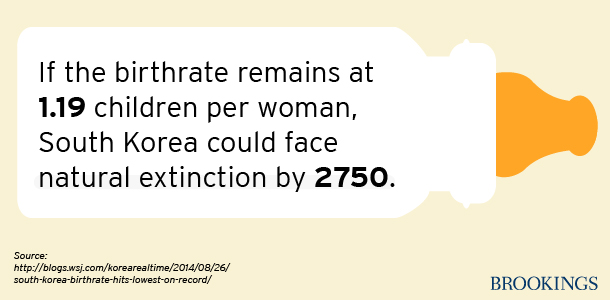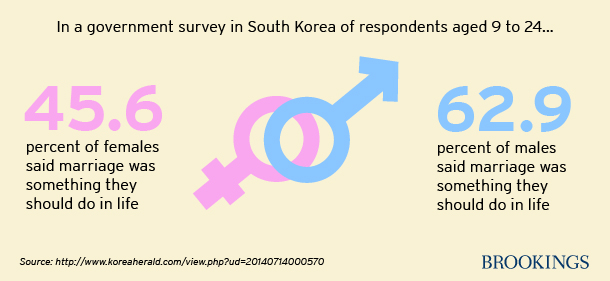People matter in foreign policy. The direction and priorities leaders set matter for national and global politics, of course. But we pay little attention to personal choices and demographic changes that add up to larger trends and substantive policy challenges in national security policy and foreign relations. Demographic changes in the Republic of Korea (ROK or South Korea) are a case in point. Marriage as a personal aspiration is on the decline among girls and young women. Birth rates have plummeted, while the population is the fastest-aging among OECD countries. And immigration is challenging age-old notions of what constitutes the Korean nation.
Low birth rates for Korea’s future
Demographic crisis spells trouble for economic productivity and growth in the long run, and declining birthrates mean declining numbers of young people available for military service.

The fact that the ROK has one of the lowest fertility rates in the world has prompted existential anxiety and policy adaptation. A 2014 study commissioned by the national legislature concluded that South Koreans could “face natural extinction by 2750 if the birthrate were maintained at 1.19 children per woman—assuming no reunification with North Korea or significant inflow of migrants.”
How such demographic changes affect South Korea’s future and its relations with other countries needs attentive assessment and analysis.
Fewer than 50 percent of young Korean women are interested in marriage

Women from the countryside migrate to urban areas in search of jobs and upwardly mobile husbands. In urban areas, they eschew middle-age bachelors or divorced men seeking wives. In general, South Korean girls and women are less interested in marriage than ever before. A recent government survey reported that only 45.6 percent of female respondents aged 9 to 24 said marriage was something they should do in life, in contrast to 62.9 percent of males. In a survey of 2,361 college students, 47 percent of women did not believe marriage is necessary.
The need for in-migration of foreign women, which is officially facilitated by the ROK government, reflects these changes in Korean women’s attitudes toward marriage and the rapidly plummeting birthrate as national policy priorities. The birth rate among immigrant mothers is higher than that of native Korean women, and the number of school-age children from mixed ethnic families enrolled in schools grew more than seven-fold from 9,389 in 2006 (the first year the government began compiling official figures) to 67,806 in 2014. In contrast to a precipitous decline in the 9 to 24 age group of native Koreans, the number of adolescents of mixed-ethnic backgrounds (“multicultural families”) increased by more than 21 percent from 2013 to 2014. China, Vietnam, and the Philippines are the top sending-countries of marriage migrants in Korea.
The face of the homogeneous South Korea we once knew is literally changing before our eyes as hundreds of thousands of foreign-born women marry Korean men and become Korean citizens and their multiracial/multi-ethnic children increase in numbers. An estimated third of all children born in 2020 (1.67 million) are expected to be of part Korean and part other Asian descent (“Kosian”), composing 3.3 percent of the total population. By 2020 and 2030 respectively, an estimated 5 percent and 10 percent of the South Korean population will be composed of foreign-born and immigrant families.
Immigration is necessary to sustain Korea’s labor force and military
Economic necessity supports in-migration as the total size of South Korea’s labor force is expected to peak in 2016 to 2017 and decline thereafter. Economic growth would shrink to 2.5 percent in 2050, compared with 4.2 percent in 2011. In December 2014, the Korea Economic Research Institute issued a report concluding that continued and increased immigration is the only viable way to sustain an adequate labor force and economic growth (4.3 million in 2030; 11.8 million in 2050; 15.3 million in 2060).
In the security sector, ROK military officials are formulating future troop size based on the declining number of potential recruits and planning reductions from 552,000 troops to 387,000 by 2020. In February 2012, the compulsory military service law was changed to increase the eligibility pool and reflect a growing heterogeneous population. Language emphasizing ethnonationalism (“serving the nation and ethnicity”) was deleted and replaced with “serving the nation and its citizens.” The law formally recognized a multi-ethnic ROK military, requiring all male citizens, regardless of ethnic background, to perform the mandatory military service expected of all able-bodied Korean men. Prior to this revision, the law exempted men who visibly appeared to have phenotype (physical) features that reflected a mixed-race background from performing the mandatory service.
Contemporary young Koreans are more civic-minded and less fixated on ethnonational markers of identity in comparison to their age group 10 years ago and to the older generation today. They are more open-minded about the requirements of “Korean-ness.” A 2014 study by Asan Institute revealed that although 80 percent of South Koreans in 2005 and 2010 prioritized Korean bloodline as essential to being Korean, the numbers dropped to 65.8 percent in 2013, and 30.4 percent thought that sharing the same bloodline is not important to being Korean. Being born in Korea, another requirement, decreased similarly.
The ROK government also is hopping along to adapt to demographic changes: Elementary school textbooks including sections on bi-ethnic/bi-racial children and multicultural families are in planning so as to educate and acculturate the majority population to the increasing heterogeneity in their midst.
Immigration will strengthen Korea’s foreign ties
Domestic politics will surely be affected by demographic changes, but so will foreign policy. For example, South Korea already has been reaching out to Southeast Asia, strongly signaling the importance of good neighborly relations as the ROK’s multiple interests in Southeast Asia grows. President Park Geun-hye promoted “VIP” (Vietnam, Indonesia, Philippines) as one of her first foreign policy priorities upon assuming the presidency in 2013. In September and October 2013, she traveled to Southeast Asia for four meetings. After the United States and China, this was the area of choice for Park’s initial state visits, and she received Benigno Aquino III, president of the Philippines, as her first state visitor (October 2013).
People-to-people ties between Korea and the Philippines as well as Vietnam are of growing importance in the respective bilateral relationships. As demographic changes deepen in Korea, the question about their impact on U.S.-Korea relations becomes salient.
How will multiculturalism play a part in Korea’s future?
The growing number of immigrants begs the question of how their acculturation in Korean society facilitates their identification with core security interests—including the U.S.-Korea alliance—or not.
How will immigrants and their children, who do not share the historical background and legacy of ties with the United States that have been common to South Koreans, regard the alliance relationship? How do the majority of immigrants, who hail from China, view Korea’s ties with their homeland and with the United States? How will the change from mono-ethnic to multi-ethnic nation affect inter-Korean relations and the politics of unification?
With regard to the United States, how might the growing heterogeneity of the ROK military affect cooperation with U.S. troops? It is possible that a diversity of faces and cultural backgrounds among ROK troops will make American service personnel in the ROK, who are racially and ethnically diverse, feel more at ease when working with South Korean counterparts? It is also possible that Americans and Koreans can strengthen ties by exploring multiculturalism as part of public diplomacy in their bilateral relations.
Demographic change and policy implications will be of growing importance as the faces of Korea transform.
Come join us for further discussion at our conference on the next generation of Korea experts on June 19.



Commentary
Korea should face its demographic crisis head on
June 18, 2015